
The Radioplane Target DroneOQ-3 / TDD-2 and OQ-14 / TDD-3Reginald Denny (1891-1967) and Walter H. Righter (1905 - 1982)
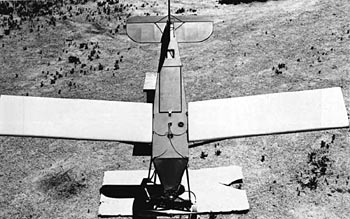 OQ-3 Photo : http://www.pimaair.org
"Looking very much like a man-carrying sport plane except for its diminutive size, the OQ-3 was the radio-controlled target drone produced in the greatest numbers during World War II. It is ironic to note that its success resulted in there being only 6 left of the 9,403 built -- a tribute to the accurate marksmanship of those who acquired their skill by shooting them down for practice." also.. some notes from http://www.designation-systems.net/dusrm/app1/oq-14.html The OQ-3, first flown in December 1943, was an improved derivative of the OQ-2. It had a sturdier steel-tube construction in the fuselage, an uprated O-15-3 engine driving a single propeller, no landing gear, and modified equipment. The OQ-3 could achieve a speed of 165 km/h (102 mph). The U.S. Navy variant was designated TDD-2, and Radioplane and Frankfort eventually built a total of about 9400 examples of this drone.
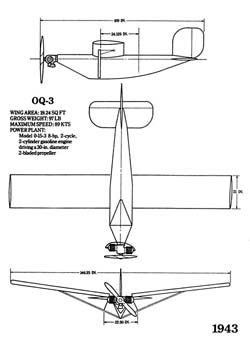 OQ-3, 3View Illustration - http://technosport.narod.ru
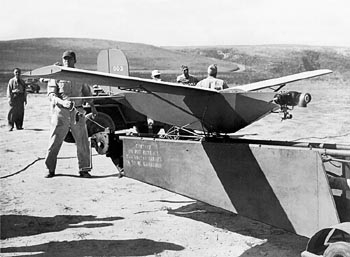 OQ-3, Righter O-15-3, El Paso, Texas, 1941 Photo: Righter Family Archives - Click Image to Enlarge Download a 1500 pixel image
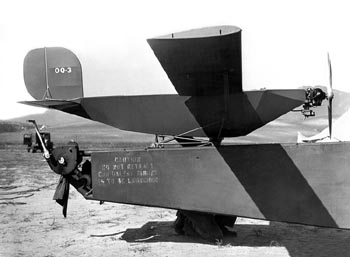 OQ-3, Righter O-15-3, El Paso, Texas, 1941 Photo: Righter Family Archives - Click Image to Enlarge Download a 1500 pixel image
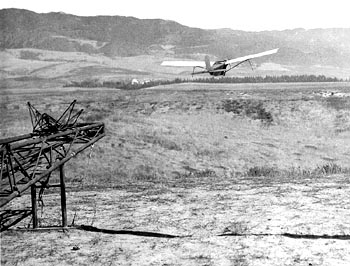 OQ-3 Photo: Righter Family Archives - Click Image to Enlarge Download a 1500 pixel image
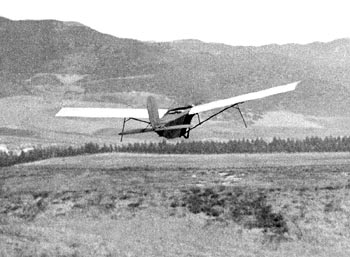 OQ-3 (detail) Photo: Righter Family Archives - Click Image to Enlarge
Radioplane OQ-7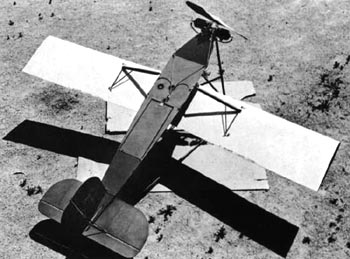 OQ-7
In November 1943, Radioplane completed the OQ-7, a derivative of the OQ-3 for increased performance. It had a new mid-mounted and slightly swept-back wing, but was otherwise identical to the OQ-3. The top speed increased to 180 km/h (112 mph), but the OQ-7 was not produced, presumably because of the more extensively improved and higher-performing OQ-14
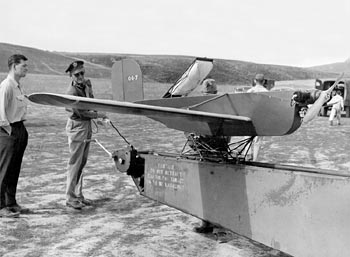 OQ-7, probably Righter O-15-3, probably El Paso, Texas, 1943 Photo: Righter Family Archives - Click Image to Enlarge Download a 1500 pixel image
Radioplane RP-8 / OQ-14 / TDD-3 and 4Some notes from http://www.designation-systems.net/dusrm/app1/oq-14.htmlRadioplane's model RP-8 was a significantly improved OQ-3/TDD-2 and was first flown in July 1944. It was of heavier construction and had a more powerful O-45-1 engine, rated at 16 kW (22 hp). Compared to the OQ-3, the RP-8A also had a longer fuselage, a shorter wingspan, and wings set flush with the fuselage. The improvements increased the top speed to 225 km/h (140 mph). The RP-8 was designated OQ-14 by the Army Air Force and TDD-3 by the Navy. A total of about 5200 RP-8A drones were built by Radioplane and Frankfort. The designation TDD-4 referred to a TDD-3 variant with a more powerful O-45-35 engine.
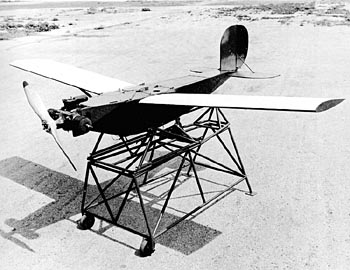 OQ-14
Photo: Botzum, Richard A., 50 Years of Target Drone Aircraft, Northrop Corp., 1985 Download a 1500 pixel or 2500 pixel image
Radioplane RP-10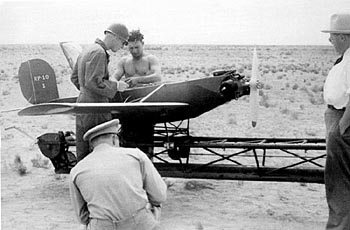 RP-10, Walter Righter supervising the training of army personnel Photo : Righter Family Archives - Click Image to Enlarge
Radioplane RP-14 / OQ-6, RP-15 / OQ-6ASome notes from http://www.designation-systems.net/dusrm/app1/oq-14.htmlIn November 1944, Radioplane completed their model RP-14, which was evaluated by the USAAF as the OQ-6. The OQ-6 was more powerful than Radioplane's contemporary OQ-3, reaching a speed of 270 km/h (168 mph) with its 16 kW (22 hp) Righter O-45 four-cylinder engine. The model RP-15, first flown in January 1945 and most likely designated OQ-6A, had a 44 kW (60 hp) McCulloch O-90 engine, and could reach a speed of 313 km/h (195 mph).
 Radioplane RP-14 / OQ-6, RP-15 / OQ-6A Photo: Righter Family Archives - Click Image to Enlarge Download a 1500 pixel image
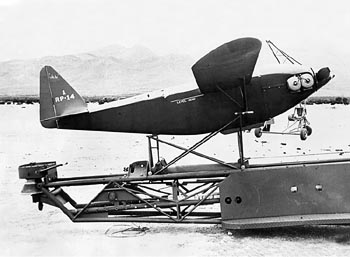 RP-14 'jake', 1944 Photo : Righter Family Archives - Click Image to Enlarge Download a 1500 pixel image
The American Magazine, 1947 "Almost any fairly frequent movie fan of the last 20 years knows Reginald Denny as the guy who plays those likeable but dim-witted Britisher roles; but relatively few know there is another and for more important side to the actor. He is the inventor of a midget robot plane - very, very hush-hush during the war and used extensively by both Army and Navy Air Forces as targets in the training of aerial and antiaircraft gunners."
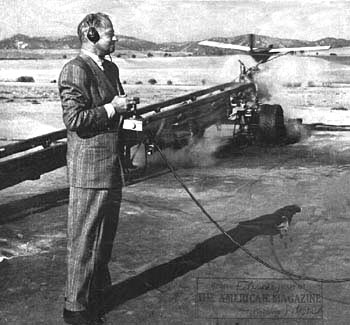 Reginald Denny, OQ-3 launch The American Magazine, 1947 - Click Image to Enlarge>
Then, back In 1934, Denny had his idea of the radio controlled target plane for gunnery training, and no one would listen to him, but when the war came on, the Government took interest, and had him manufacture them in quantities. They are named after the actor, being called Target Drone Dennys."
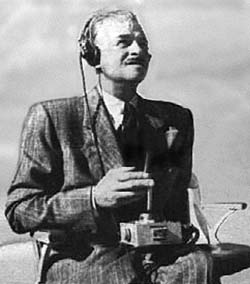 Reginald Denny The American Magazine, 1947 - Click Image to Enlarge>
Denny's latest film role was in "Mr. Blandings Builds His Dream House". He has 3 children and his principal diversions aside from the robots, are gardening, painting, and sailing."
Reginald Denny's Drone : Actor Played Important Role In Defense Work The Los Angeles Times published an article after Reginald Denny had died that illustrates his significant influence. No modeler has had this kind of impact on the aerospace industry. The article also published a rare picture of a pre WWII test of an early drone.
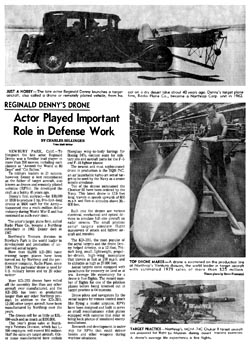
Reginald Denny's Drone Los Angeles Times, 1979 - Click Image to Enlarge> Download a 1500 pixel image
Transcript by Pete Soule
Reginald Denny's Drone NEWBURY PARK, California -To filmgoers the late actor, Reginald Denny, was a familiar lead player in more than 200 movies, including such classics as "Around the World in 80 Days" and "Cat Balou". To Military leaders in 20 nations however, Denny is recognized as the father of target aircraft, also known as drones and Remotely Piloted Vehicles (RPVs). He developed the craft as a hobby 45 years ago. Denny's first contract-for $30,000 in 1938 to produce 3 hp, 8 1/2-foot long drones at $600 each for the Army -- blossomed into a multi-million dollar industry during World War II, and has continued as such ever since. The actor's target plane firm, called Radioplane Co. became a Northrop subsidiary in 1962. Denny died in 1967. Northrop Ventura Division in Newbury Park is the world leader in development and production of unmanned aerial targets. More than 85000 KD-2R5 basic training target planes have been turned out by Northrop and the predecessor company, Radioplane since 1964. This particular drone is used by U.S. military forces and by 20 other nations. More KD-2R5 drones have rolled off the assembly line than any other aircraft ever manufactured and the KD-2R5 has been in production longer than any other Northrop product. In addition to the KD-2R5, 12,000 other target aircraft have been manufactured by Northrop over the years. The drones sell for as little as $25,000 each and as much as $100,000. This year's gross sales at Northrop's Ventura Division, which has 1000 employees, will exceed $50 million. Half the sales are aircraft. Other items manufactured here include fiberglass wing-to-body fairings for Boeing 747's, ejection seats for military jets and aircraft parts for the F-5 and F-18 fighter planes. The newest and most sophisticated of these target drones is the ROM-74C, an air launchable turbo-jet aerial target to be used by the Navy as a cruise missile simulator. Ten of the drones nicknamed the Chuckar III have been ordered by the Navy. This latest drone is 12.9 feet long, travels at speeds upward of 600 m.p.h. and flies at altitudes above 30,000 feet. Built into these drones are various electrical, mechanical and optical devices to simulate full-size aircraft on radar screens. The small pilotless aerial targets simulate flight maneuvers of attack fighter aircraft and missiles. The KD-2R5. the most popular of the aerial targets and the drone Denny helpe d develop, is a 12-foot 71/2 inch long, small, lightweight, propeller-driven, high wing monoplane that travels as fast as 250 m.p.h. and to altitudes as high as 27,000 feet. Aerial targets come equipped with parachutes for recovery on land or at sea. Average life expectancy for a drone is five flights. The record number of flights for one of the pilotless planes before being knocked out in target practice is 64 missions. Drone pilots and navigators fly the aerial targets by remote control much like flying a model airplane. RPVs have been designed and built to serve as small robot planes equipped with cameras that relay or bring back photos of simulated enemy installations. Research and development is under way for RPV's that could deliver bombs and other weapons during wartime situations.
'Bare Navy War on Japs'
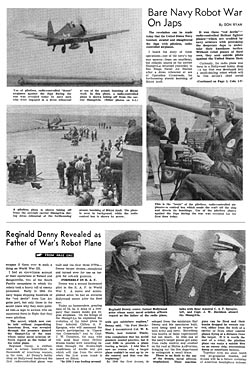 'Bare Navy War on Japs' Los Angeles Times - Click Image to Enlarge> Download a 2500 pixel [3.2Mb] image
Dr Naughton, Thanks very much for you kind reply to my e-mail. Here is some rather "sketchy" information [on the Radioplane and Radioplane Co. - Ed], some of which you may find interesting. I am now seventy years old, and was a young child when Reginald Denny Industries was formed in 1935. My father sold Reginald Denny Industries in 1939, when Radioplane Co. was formed. Walt Righter produced the opposed twin cylinder engines and opposed four cylinder engines for the Radioplane drones until about 1945, at which time McCulloch began to supply a four cylinder engine for the OQ-6. During about 1946, beginning with the OQ-19, I believe McCulloch began building all engines for the Radioplane drones. The RP-1 pictured in your site, really never had a successfully controlled flight. Nor did the RP-2, or RP-3. The RP-4 was successfully flown in 1939, and the first Army contract was issued for five of these planes. This first contract was issued as a result of a demonstration flight during which, the aircraft went completely out of control. The Army was so impressed with the, unknown to them, out of control aerobatics of the aircraft, they issued the contract despite the fact the plane crashed. I recall my father discussing, how concerned he was at the time, that the out of control RP-4 may crash into the viewing stands. The RP-1, I believe, was fitted with two electric train motors each on its own frequency. One for elevator control and the other for rudder control. The idea was, that when current was applied to one motor this would be "up" elevator. The next signal would be stop or neutral elevator and the next "down". The same sequence with rudder control. The control box consisted of a rotary telephone type unit. None of this functioned properly. Eventually Bendix Aviation manufactured the receivers and I believe the actuators. Doolittle Radio company I believe built the transmitters. During the time my father was with Radioplane company numerous models were built, but not all were supplied under contract to the U.S. government. Some of these were: Army designation OQ-2A; OQ-2B. (Navy designation TDD-1); OQ-3; OQ-7; RP-9; and OQ-14, (Navy TDD-3) 15, 16 through RP-35. The RP-9 was the first Radioplane drone to use aileron control surfaces. In about 1948 my father foolishly sold his stock representing 25% ownership of Radioplane Co. to Whitley Collins, president of Radioplane Co. I was given a book published by Northrop Aircraft in 1985 written by Richard A. Botzum 50 Years of Target Drone Aircraft. I doubt however, any of copies are available now. This book covers in great detail, development of unmanned radio-controlled target aircraft from 1935 through 1985. Reg On Mon, 11 Feb 2002 Reginald Denny (Jr) wrote to this site with regard to the page on his father
"This is a complete bit of nostalgic trivia which has been researched, compiled and published pertaining to my father and Radioplane Co. It's more complete in some respects than what I have. Thanks very much, to whomever has taken time to research and publish this.back to Reginald Denny (Jr)'s second and detailed eMail
Hello ! Norma JeaneThe other notable person in the Radioplane story is a woman; but not just any woman, for she was and remains one of the best-recognized females of the twentieth century. Her name at the time was Norma Jeane Dougherty, better known as Marilyn Monroe!
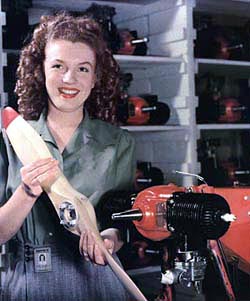 Norma Jeane Dougherty, June 26, 1945 Photo : David Conover http://marilynmonroepages.com/
The camera and the photographer loved Norma Jeane and he persuaded her to model for more photos that soon were circulating in Hollywood. A screen test, a change of name and a career very different from assembling robot planes quickly followed. The rest as they say, 'is history.'
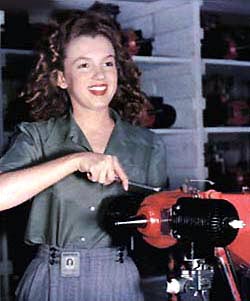 Norma Jeane Dougherty, June 26, 1945 Photo : David Conover
also see a comprehensive photo essay on Marilyn Monroe's trip to Korea in 1954 to entertain the US troops still stationed there following the Korean War.
|
© Copyright 1999-2005 CTIE - All Rights Reserved - Caution |